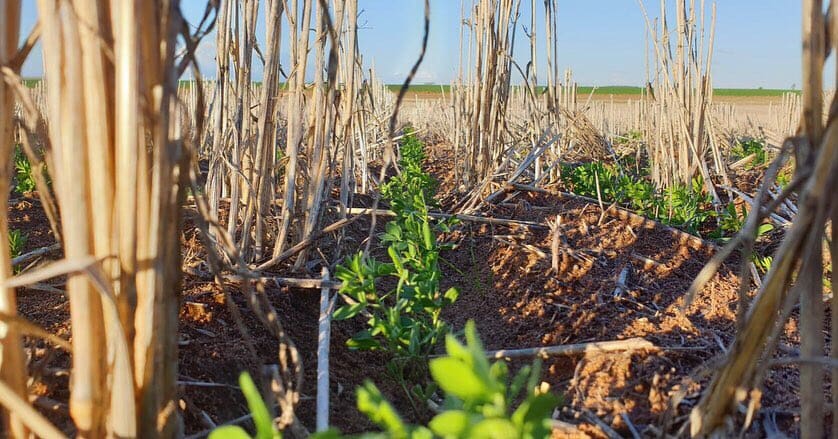
A crop of PBA Hurricane XTA lentils growing in the Victorian Mallee. Photo: CropSmart
PRODUCTION of lentils in Australia is forecast at 341,000 tonnes, up 5 per cent from the 323,000t grown last year, despite a reduced planted area, according to the latest estimate from Pulse Australia.
This forecast lift in production has come from improved yield prospects, and comes in the face of high lentil stocks, largely due to the continued absence of India as Australia’s major customer.
Pulse Australia chief executive officer Nick Goddard said there were some indications that lentil stocks were being slowly depleted.
“The stock levels, combined with access restrictions to India, have brought a bearish sentiment to planting intentions for this year, with growers favouring barley, faba beans or peas.
“Consequently, area is back by around 20pc which, offset by a yield improvement over last year, will see a slight lift in volume.”
| State | 2018 final | June 2019 estimate | ||
|---|---|---|---|---|
| Harvested hectares | Tonnes | Planted hectares | Tonnes | |
| Qld | 0 | 0 | 0 | 0 |
| NSW | 7,000 | 5,000 | 6,000 | 5,000 |
| Vic | 125,000 | 105,000 | 100,000 | 110,000 |
| SA | 160,000 | 200,000 | 124,000 | 208,000 |
| WA | 11,000 | 13,000 | 15,000 | 18,000 |
| National total | 303,000 | 323,000 | 245,000 | 341,000 |
Table 1: Red and green lentil area and production estimates. Source: Pulse Australia
Drop for lupins
National lupin production from the crop now in the ground is forecast to produce 549,000t, down 17pc from the 2018 tonnage, largely due to a swing out of lupins in Western Australia, Australia’s biggest lupin-producing state.
“The attraction of lupins as a feed source, especially for sheep, has helped shore up pricing, and consequently east coast area is up, particularly in southern New South Wales.”
Mr Goddard said the elimination of anthracnose had also aided confidence in lupins in NSW and Victoria.
“Much of the WA crop was dry sown, but timely rain in the second week of June will ensure the crop establishes well, and given an even chance of exceeding median rainfall, could see an upside in yield”.
| State | 2018 final | June 2019 estimate | ||
| Harvested hectares | Tonnes | Planted hectares |
Tonnes | |
| Qld | 0 | 0 | 0 | 0 |
| NSW | 50,000 | 38,000 | 81,000 | 100,000 |
| Vic | 30,000 | 20,000 | 33,000 | 29,000 |
| SA | 40,000 | 35,000 | 43,000 | 48,000 |
| WA | 371,000 | 570,000 | 350,000 | 372,000 |
| National |
491,000 | 663,000 | 507,000 | 549,000 |
Table 2: Sweet and albus lupin area and production estimates. Source: Pulse Australia
Repeat of 2018
Pulse Australia said this year’s dry conditions in much of Queensland and northern NSW, a late but good break in southern NSW, Victoria and South Australia, and a very late break in WA were all reminiscent of last year’s experience.
It said any rain in Queensland and northern NSW had served mostly to begin to replenish a dry profile rather than offer good seeding or germination rain.
“Growers were always going to approach winter 2019 with caution, placing their bets more favourably towards cereals than pulses or oilseeds.
“Restricted trade access for pulses, coupled with seasonal uncertainty, has led growers to temper their pulse rotations this year.”
Pulse Australia has forecast a maximum possible national pulse crop of up to 1.8 million tonnes (Mt), down slightly on last year’s crop of 1.9Mt, and some 27pc below the 10-year average.
“However, it is early in the season and the planting window for some pulses, notably chickpeas, remains open for another month or so.
“We would envisage volume forecasts in this report to be the upper end of expectations.”
| State | Chickpeas | Field peas | Faba beans | Lentils | Lupins | Total tonnes |
| Qld | 80,000-242,000 | 2,000 | 3,000 | 0 | 0 | 85,000-247,000 |
| NSW | 30,000-84,000 | 31,000 | 27,000 | 5,000 | 100,000 | 193,000-247,000 |
| Vic | 44,000 | 48,000 | 119,000 | 110,000 | 29,000 | 350,000 |
| SA | 17,000 | 119,000 | 139,000 | 208,000 | 48,000 | 531,000 |
| WA | 7,000 | 14,000 | 3,000 | 18,000 | 372,000 | 414,000 |
| National | 178,000-394,000 | 214,000 | 291,000 | 341,000 | 549,000 | 1,571,000 – 1,789,000 |
| % change on yr |
-36%-+40% | -16% | +47% | +5% | -17% | 3,144,000-3,578,000 |
Table 3: Estimated production of Australia’s major pulse crops for 2019. Source: Pulse Australia
The Bureau of Meteorology has forecast a very dry winter, and most growing regions in eastern Australia are seen as having less than a 35pc chance of exceeding median rainfall.
The first two weeks of June saw two significant fronts move across Southern Australia, dumping 50-100 millimetres of rain in many of the southern and western pulse-growing regions, with similar falls recorded in Central Queensland.
“Unfortunately, northern NSW and southern Queensland have not been able to benefit, placing further pressures on the prospects for chickpeas.”
In contrast, WA is forecast to have 50/50 chance of exceeding median rainfall this winter, and a front on the weekend has brought an ideally-timed 10-40 millimetres of rain to most of its growing areas to follow on from general rain earlier this month.
Source: Pulse Australia

HAVE YOUR SAY